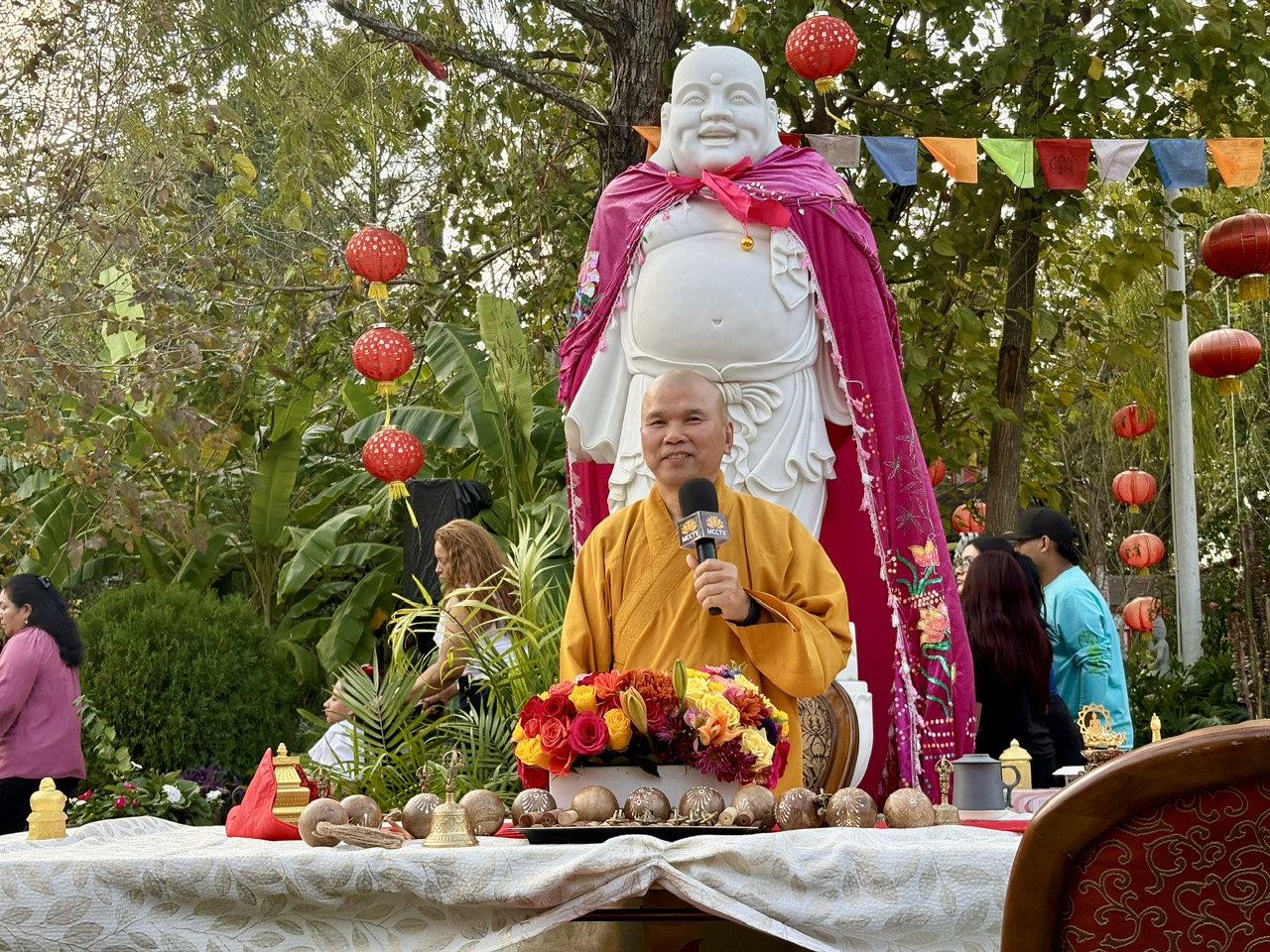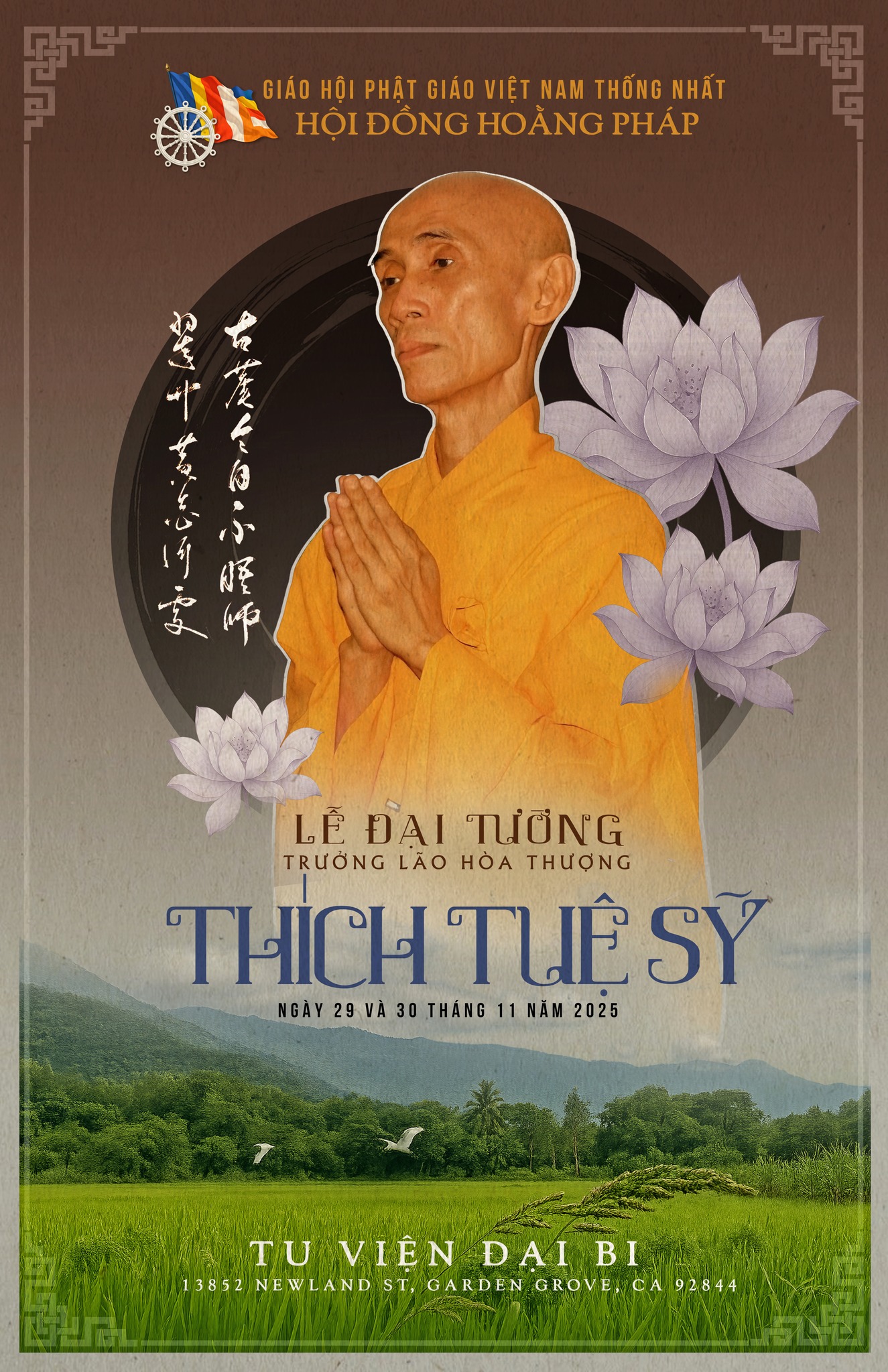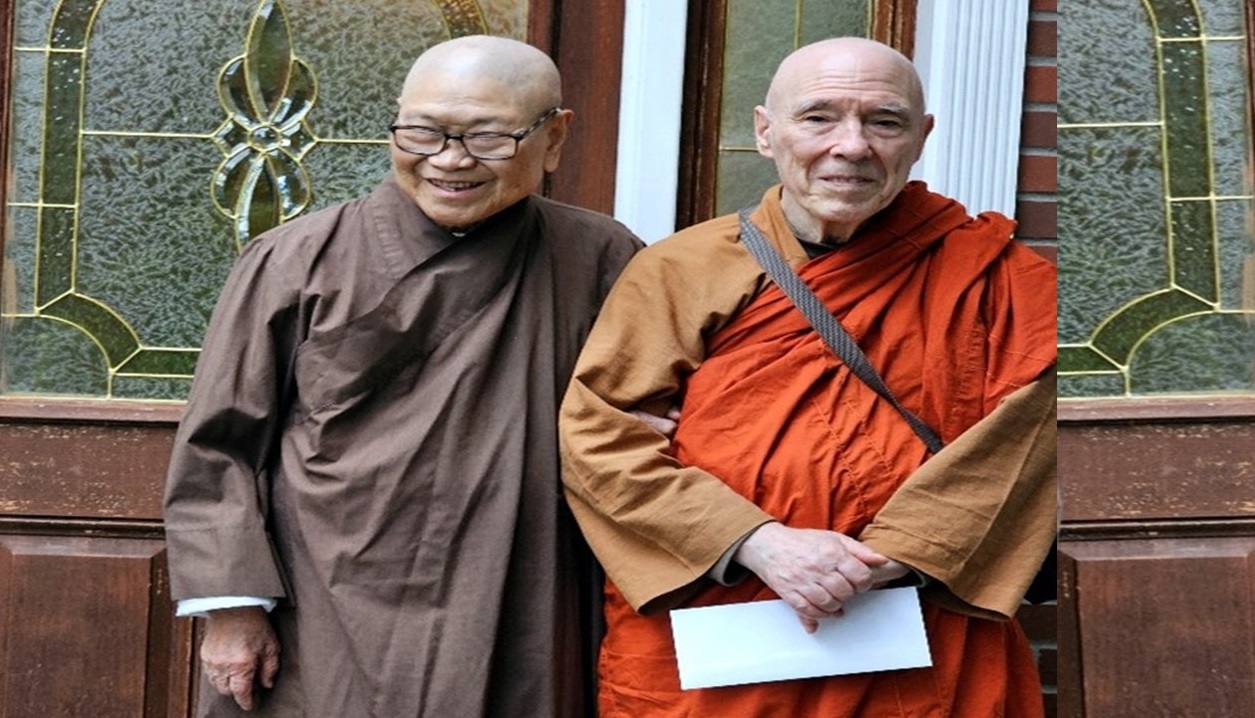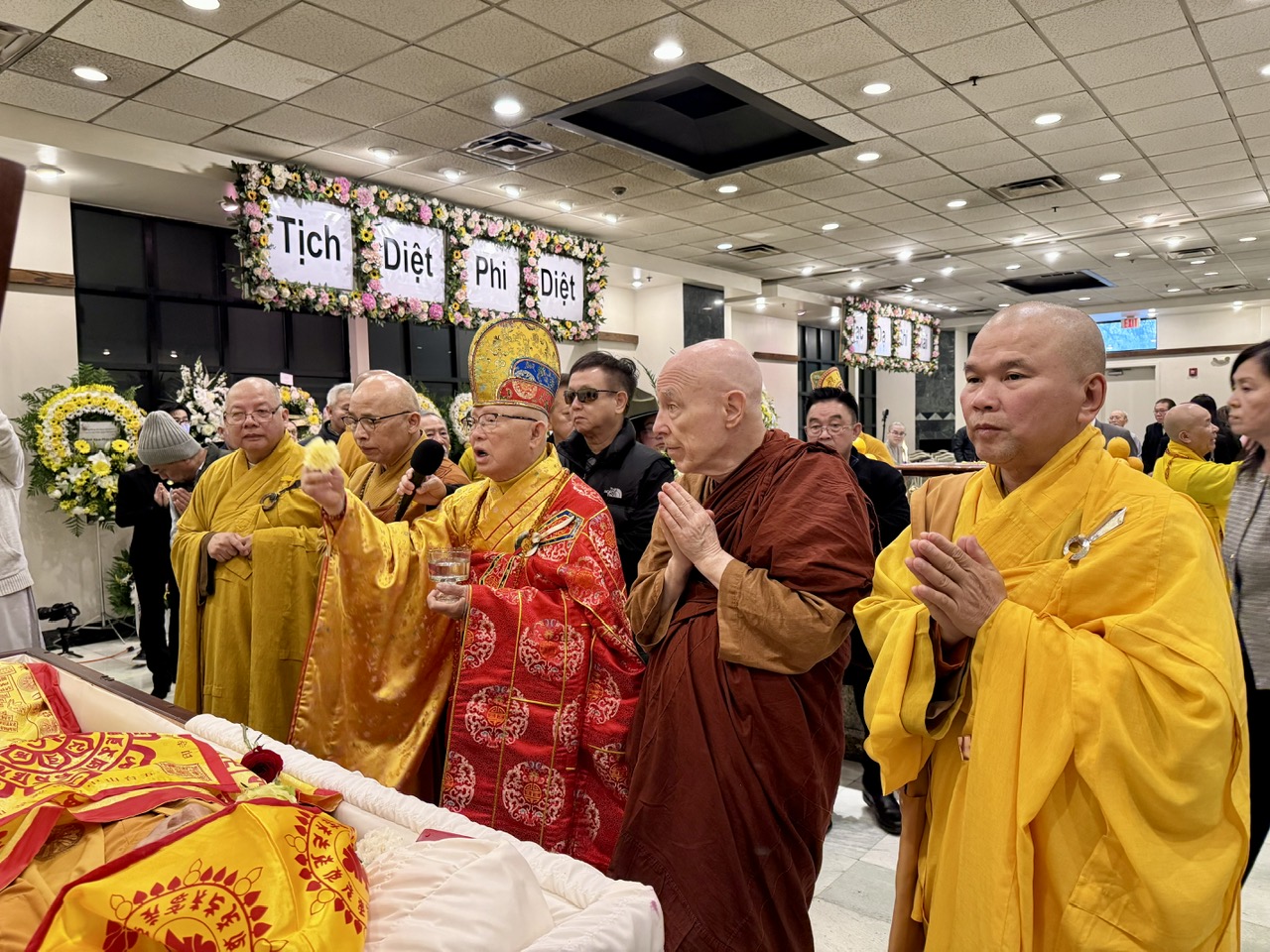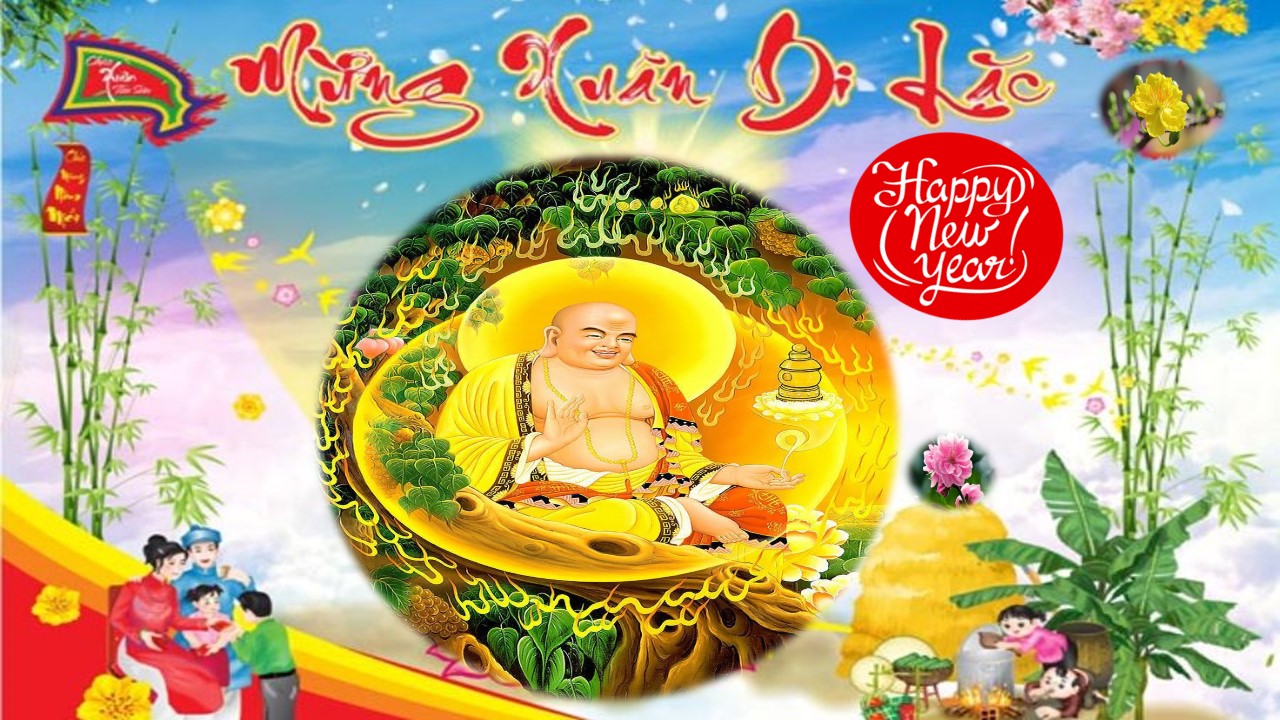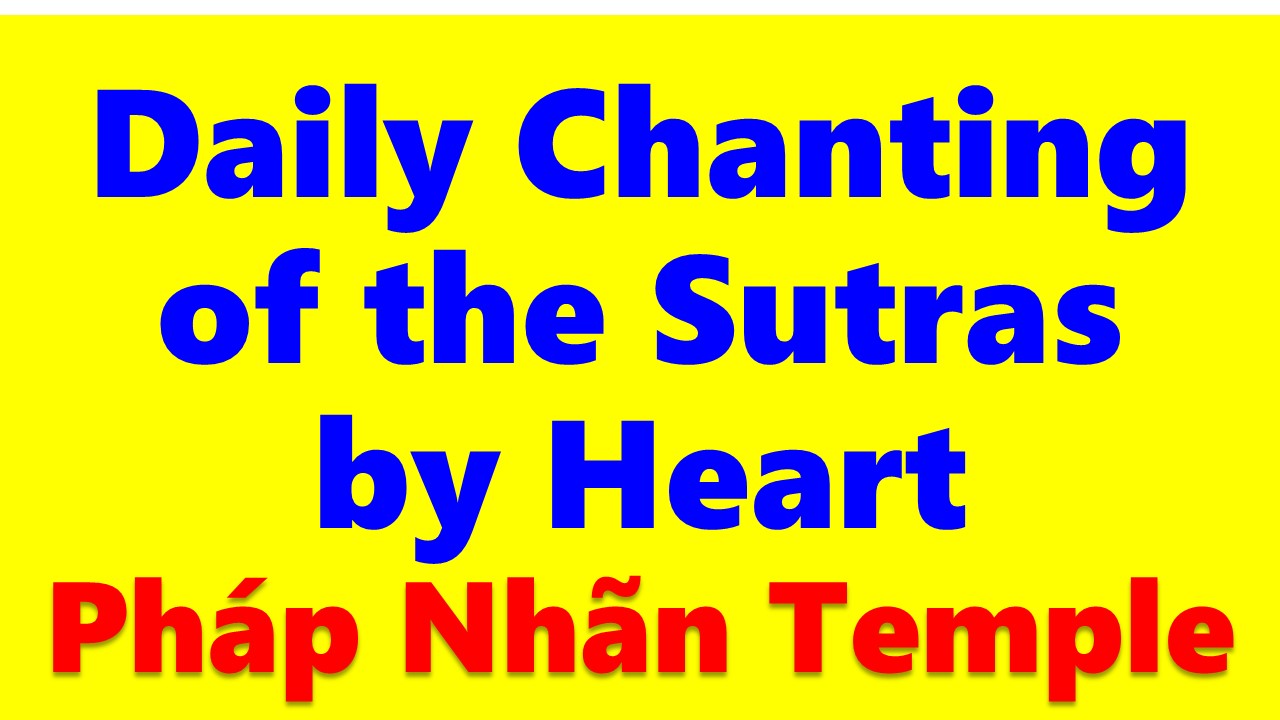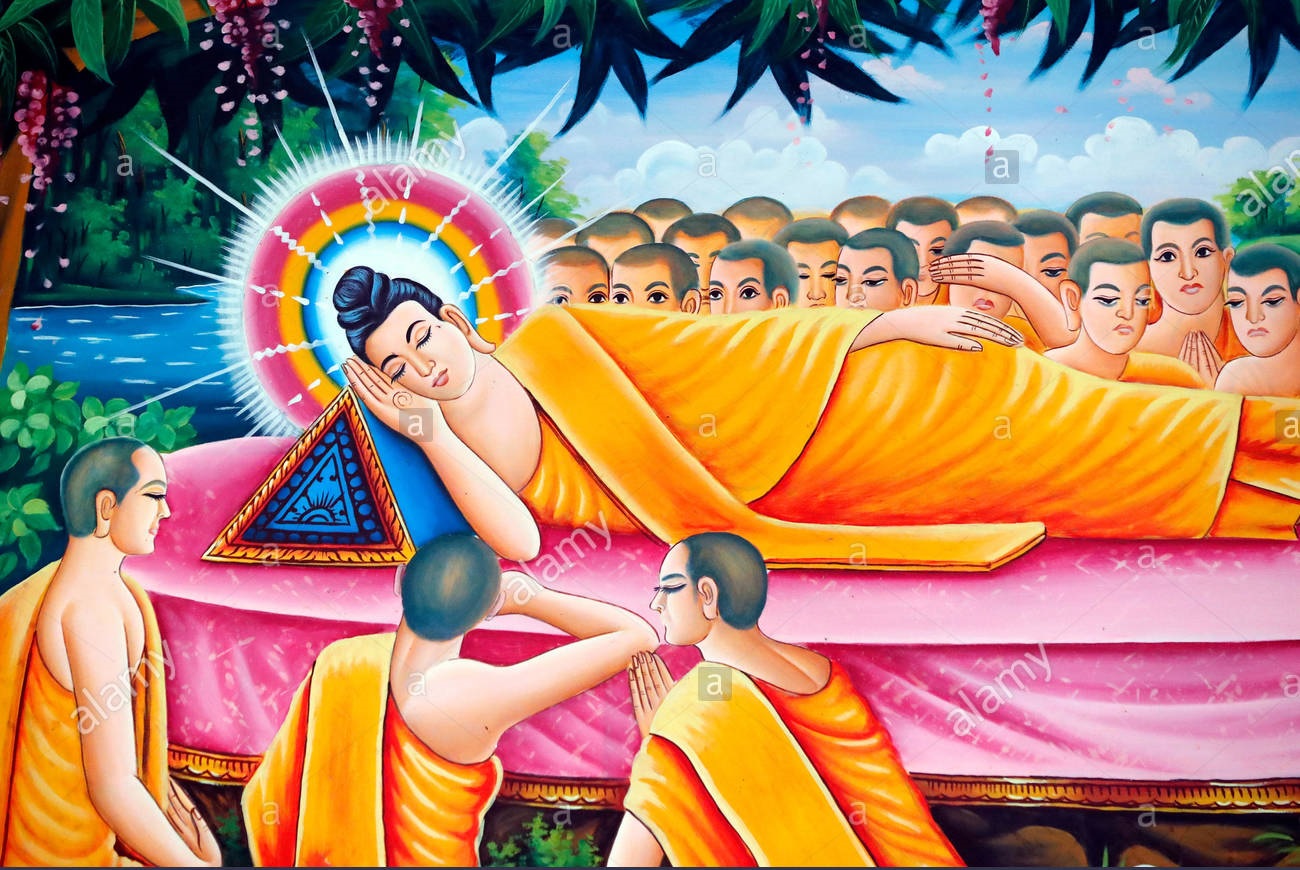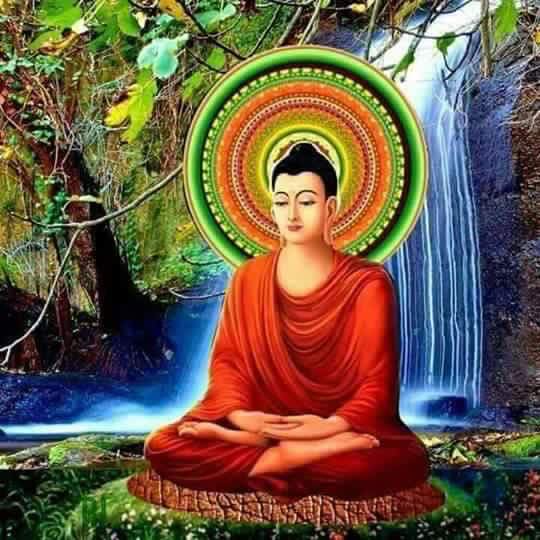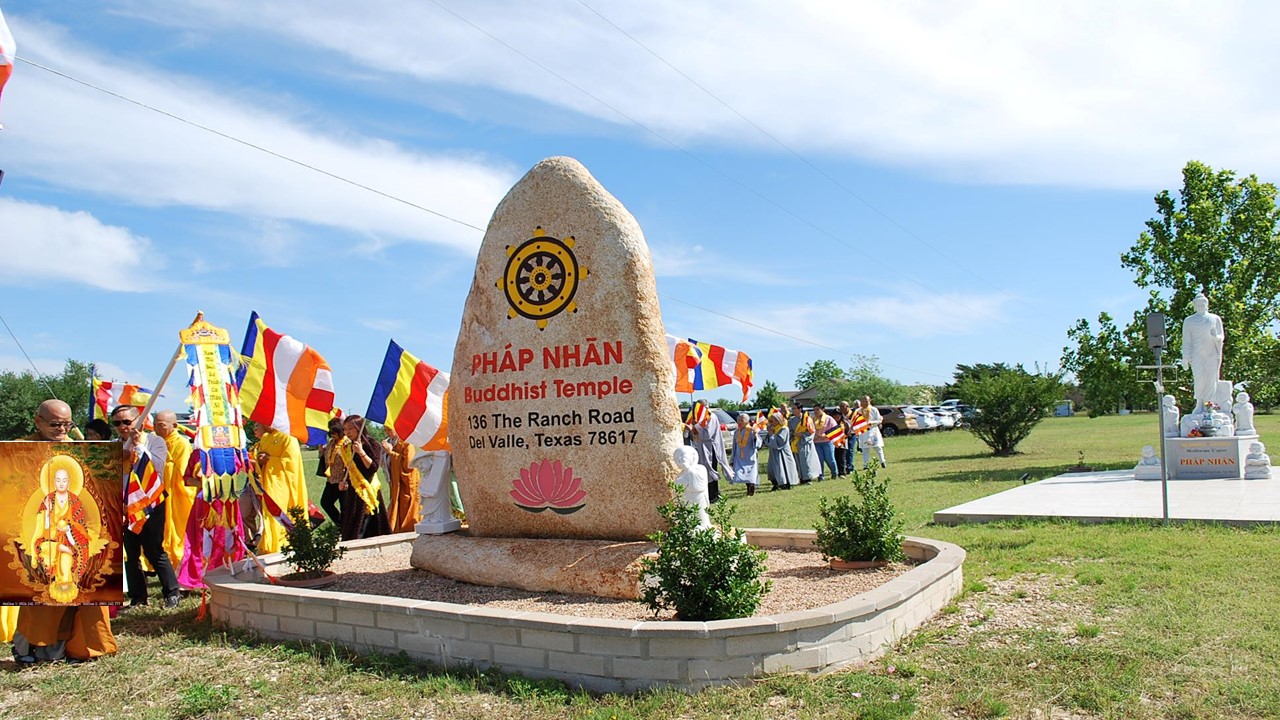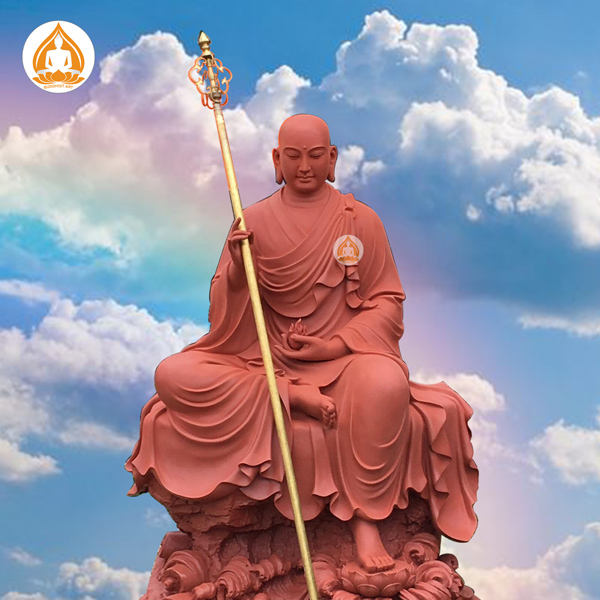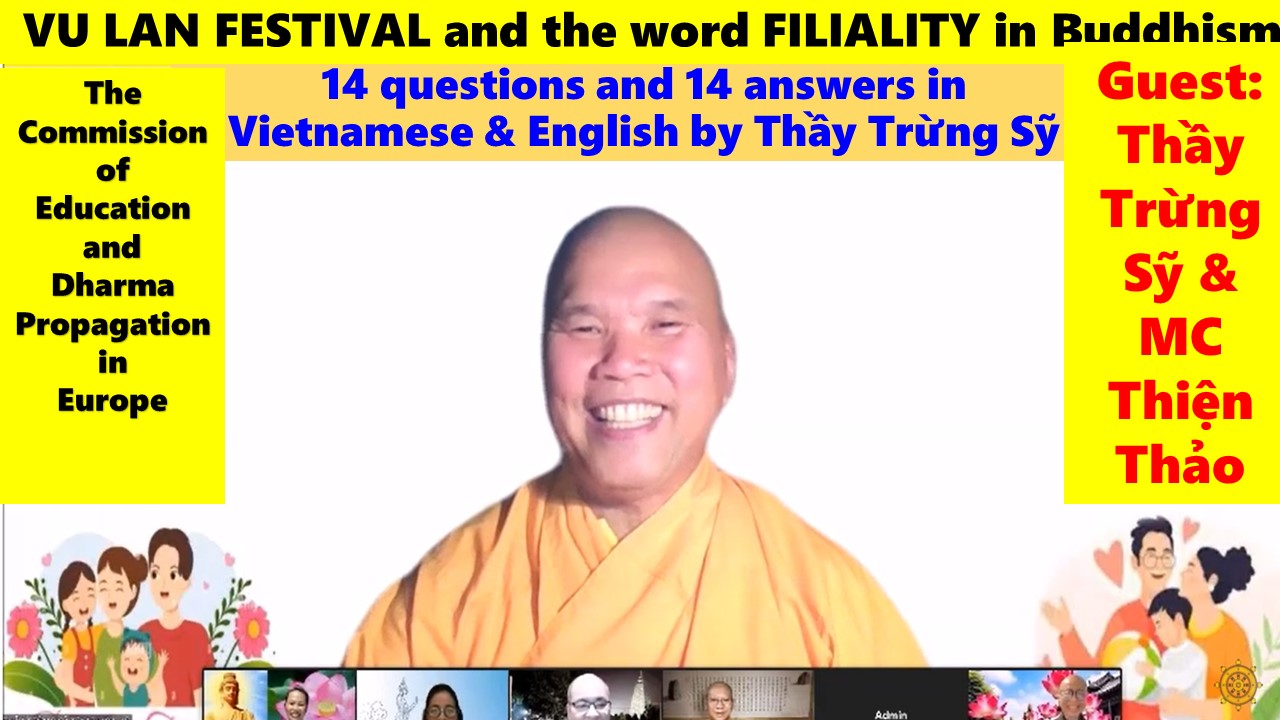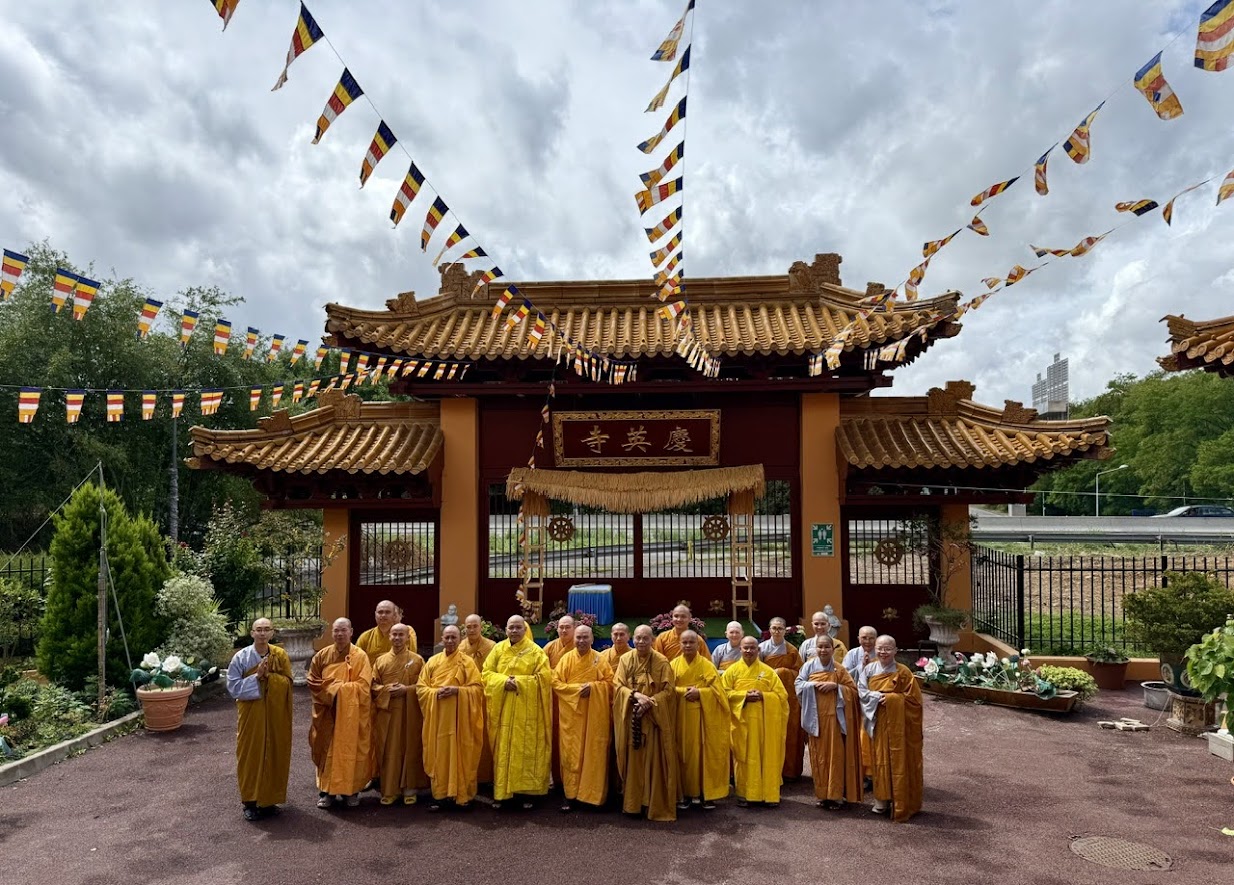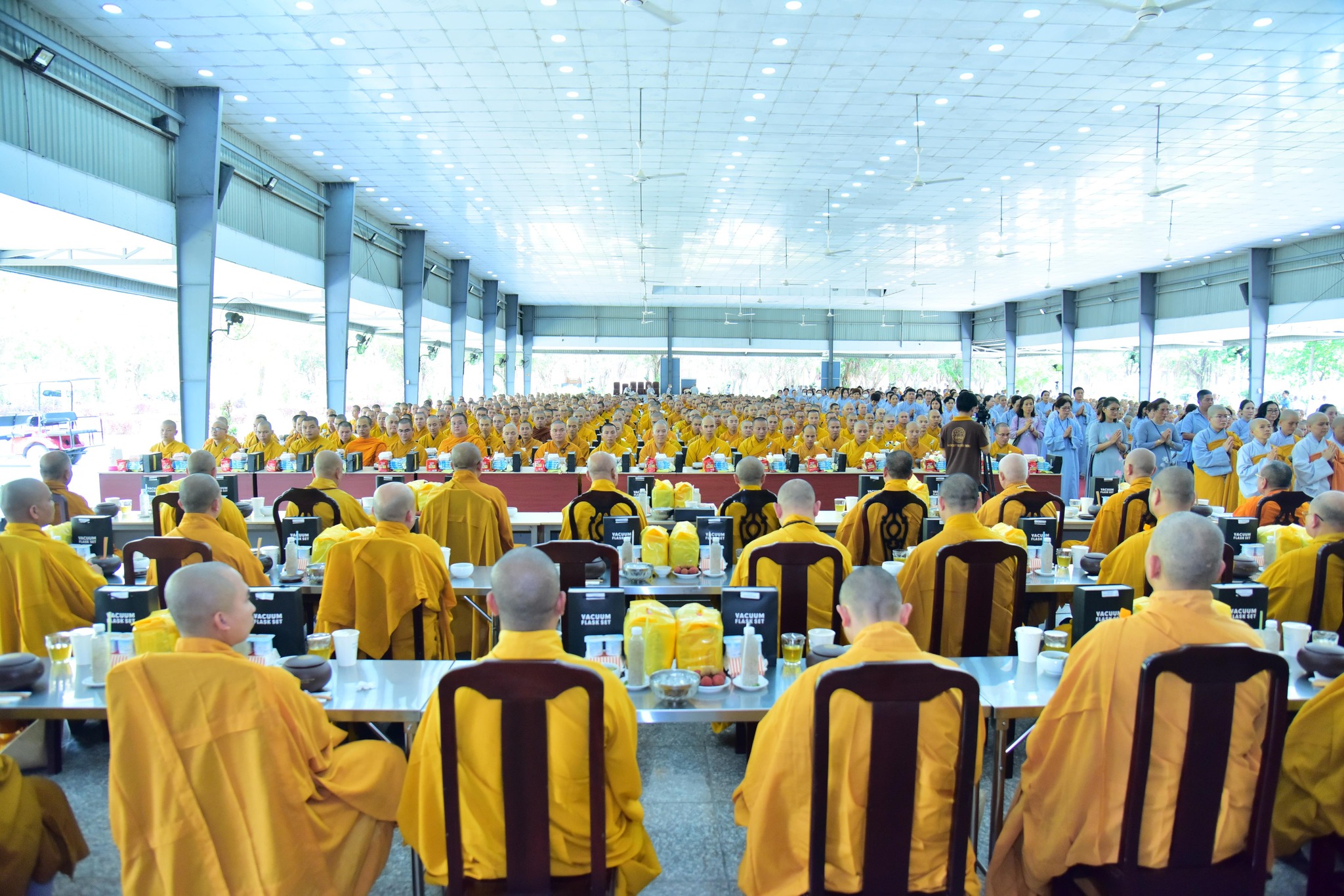Most Ven. Thích Như Điển Ven. Thích Trừng Sỹ Bhikkhuni Khánh Năng
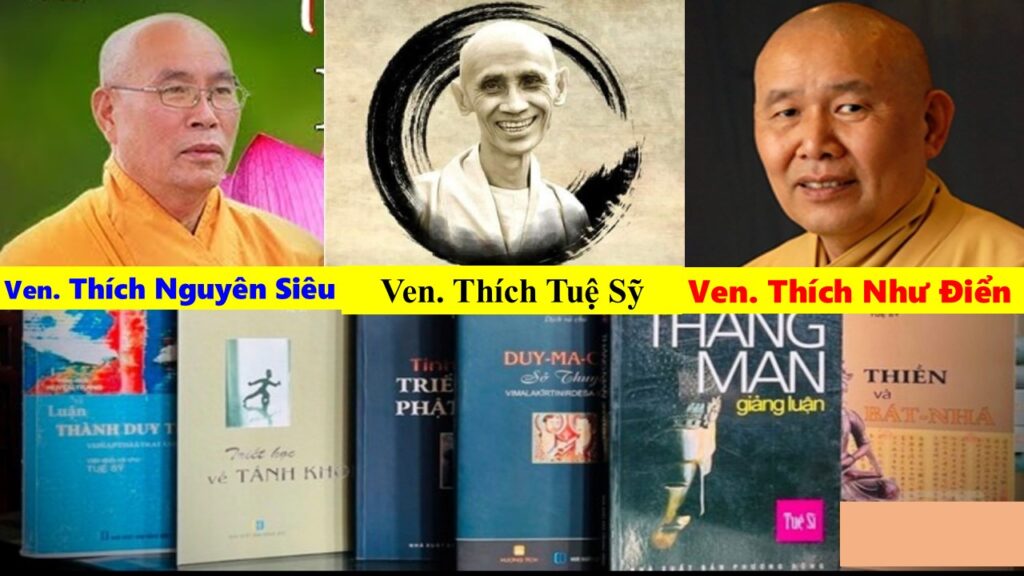
I. Introduction: Commemoration and Recognition
Namo Amitabha Buddha
Thank you Sư Cô for your introduction, and I will say a few words in English to greet the listeners. Then I will present in Vietnamese and Senior Venerable Thích Trừng Sỹ will translate my answers in Vietnamese into English, because my English ability is limited. Moreover, when answering in Vietnamese, I have more time to think and answer the Nun’ s question more deeply. Please begin with your questions.
1. The project of translating the Vietnamese Tripitaka is a great effort led by the Most Venerable Elder Tuệ Sỹ. Could you please share some thoughts on the vision and role of the Elder in leading this important project?
Answer: After the Unified Vietnamese Buddhist Congregation was established in 1964 at Xá Lợi Buddhist Temple in Saigon, Vietnam, the Institute for Sangha Supreme Patriarch immediately thought of establishing a Vietnamese Tripitaka Translation Council on October 20, 21, and 22, 1973 at Vạn Hạnh Buddhist University in Saigon, it consisted of the 18 Most Venerable Elders of the Supreme Sangha Council, including the Most Venerable Thích Tuệ Sỹ.
From 1973 until after the Vietnam War ended in 1975, due to the chaos, the Venerable Ones in the Translation Council could only translate a number of representative Sutras, Vinaya, and Abhidharma. Until December 3, 2021, a provisional Tripitaka Translation Council was established with Professor Trí Siêu Lê Mạnh Thát as advisor. The Most Venerable Thích Tuệ Sỹ in Vietnam is the President, the Most Venerable Thích Như Điển in Germany is the Chief Secretary, the Most Venerable Thích Thái Hòa is the Deputy Secretary at home, the Most Venerable Thích Nguyên Siêu is the Deputy Secretary abroad. There are many other Boards as well.
The Most Venerable Thích Tuệ Sỹ is a great master, a very outstanding Buddhist scholar in many aspects such as being fluent in many ancient and modern languages such as: Chinese, Sanskrit, Pali, Tibetan, English, French, German, etc. and he was also a former lecturer at Van Hanh Buddhist University in Saigon before 1975 as well as many other Buddhist Colleges in the country. Therefore, his role as President was very important from when establishing the Provisional Tripitaka Translation Council until his passing on November 23, 2023.
2. As a successor, how do you view the intellectual legacy, spiritual aspirations, and dedication of the Most Venerable Elder Tuệ Sỹ to Vietnamese Buddhism through this project?
On September 21, 2023, the Most Venerable Thích Tuệ Sỹ signed a document as President of the Provisional Tripitaka Translation Committee regarding the project of translating the Tripitaka after he passed away, and the content of this document is quite detailed. I will continue to answer the questions of the Venerable Nun later and a Central Translation Committee has been approved by the Most Venerable Tuệ Sỹ representing the Institute for Sangha Supreme Patriarch.
The intellectual legacy, spiritual aspirations, and dedication of Venerable Master Tuệ Sỹ can be read in this excerpt from the General Records as well as the introduction of each volume of the Sravaka Pitaka as follows:
To express the deep gratitude to the past Patriarchs and Venerable Ones of the 1973 Translation Council in the career in propagating the true Dharma, the Dharma Propagation Council vows to contribute merit, wholeheartedly support, and offer mind power and intelligence power so that the standard Vietnamese Tripitaka can be published in turn, starting from the Sravaka Pitaka, January 2022, until the completion of the Bodhisattva Pitaka and the Tantra Pitaka in the next decade…. (The Provisional Translation Council informs)
II. Vision and Origins
3. What is the initial motivation for initiating the Vietnamese Tripitaka Translation Project?
It is a continuation of the Tripitaka Translation project of the Vietnamese Tripitaka Translation Council since 1973.
4. How does this project inherit and develop the work of the Tripitaka Translation Council in 1973?
Recently in 1973 a Tripitaka Translation Council was established for the first time in history. President: The Most Venerable Thích Trí Tịnh, General Secretary: The Most Venerable Thích Quảng Độ, with members gathering all the Most Venerable Ones, Senior Venerable Ones, and Venerable Ones who have had translation project, and has prestige on the aspect of Buddhist studies, under the direction of the Institute for Sangha Supreme Patriarch of the United Vietnamese Buddhist Congregation. The translation program was drafted on a large scale, but due to the war situation, only a small part of it was implemented. A part of this achievement was later published in 1993 by the Vietnam Buddhist Research Institute, affiliated with Vietnam Buddhist Sangha, under the title: Vietnamese Tripitaka.
This achievement is the sutras of the Agamas assigned by the Tripitaka translation council, in which, the (Digha) Long Agama and (Saṃyukta) Miscellaneous Agama were translated by the Most Venerable Thiện Siêu, the Most Venerable Trí Thành, and the Most Venerable Tuệ Sỹ of the Institute of Hải Đức Buddhist Studies college in Nha Trang, the (Madhyama) Middle Agama and (Ekottara) Gradual Agama were translated by the Most Venerable Thích Thanh Từ, the Most Venerable Bửu Huệ, and the Most Venerable Thiện Tâm of the Huệ Nghiêm Buddhist Studies College in Saigon. In addition, a part of other merit has also been completed such as:
The Most Venerable Trí Nghiêm: The Maha prajnaparamita Sutra – The Heart of the Perfection of Wisdom Sutra (translated by Xuanzang in 600 volumes) belongs to the Prajnaparamita collection. The Most Venerable Trí Tịnh: The Maha Prajnaparamita Sutra (Major Chapter) belongs to the Prajnaparamita collection, Saddharma Puṇḍarīka Sūtra – the Sutra of the Lotus Flower of the Wonderful Dharma (translated by Kumarajiva) belongs to the Lotus collection, the Mahāvaipulya Buddhāvataṃsaka Sūtra (80 book edition) belongs to the Avatamsaka collection, and (Mahāratnakūṭa Sūtra) the entire Jewelled-accumulation sùtra.
III. Translation Philosophy and Academic Approach
5. What core principles guided translation approach of the project?
Building upon the Vietnamese Tripitaka translation project in 1973 and that of the Most Venerable Tuệ Sỹ that was previously formed, we continue this endeavor, and those who specialize in Sutras, Vinaya, and Abhidharma will be assigned according to the capacity of these translators.
6. How does the translation team balance faithfulness to the original text with making the translation accessible to modern Vietnamese readers?
In the past and even in the present, all translations have been based on the Taishō Shinshū Daizōkyō (Taishō Tripitaka) in classical Chinese for translating into Vietnamese, but there are also many Sutras that need to be compared with the original Sanskrit, Pali or Tibetan texts for cross-referencing. When translating, if translators have doubts about the authenticity or meaning of the ancient Chinese text, especially ancient terms, they should pay attention to translating them into modern Vietnamese for easy understanding. At the same time, they must still keep the original ancient Chinese text in the translation so that they can be compared when needed.
7. When there are differences between the Chinese translations and the original Pāli or Sanskrit texts, how does the translation team handle them?
We will select translations that have been cross-checked with Sanskrit, Pali or Tibetan sources, (if available) to create a translation as reliable as the classical Chinese translation. At the same time, the Vietnamese version will be selected or edited according to the translator’s insightful judgment.
8. When the original Sanskrit sources were lost, what methods are used to ensure that the Vietnamese translation remains as accurate as possible?
Due to the differences between the textual traditions of the different schools, in order to have an understanding of the original teachings common to all requires extensive comparative research. This work is beyond the present capacity of the translators. However, whenever possible, differences between the various textual traditions will be recorded and compared. In such cases, the translator will consult parallel Sutras, alternative Chinese translations, and infer the possible original forms in the Sanskrit text for the purpose of correction. All such corrections will be noted in the footnotes.
The Most Venerable Trí Nghiêm: The Maha prajnaparamita Sutra – The Heart of the Perfection of Wisdom Sutra (translated by Xuanzang in 600 volumes) belongs to the Prajnaparamita collection. The Most Venerable Trí Tịnh: The Maha Prajnaparamita Sutra (Major Chapter) belongs to the Prajnaparamita collection, Saddharma Puṇḍarīka Sūtra – the Sutra of the Lotus Flower of the Wonderful Dharma (translated by Kumarajiva) belongs to the Lotus collection, the Mahāvaipulya Buddhāvataṃsaka Sūtra (80 book edition) belongs to the Avatamsaka collection, and (Mahāratnakūṭa Sūtra) the entire Jewelled-accumulation sùtra.
III. Translation Philosophy and Academic Approach
5. What core principles guided translation approach of the project?
Building upon the Vietnamese Tripitaka translation project in 1973 and that of the Most Venerable Tuệ Sỹ that was previously formed, we continue this endeavor, and those who specialize in Sutras, Vinaya, and Abhidharma will be assigned according to the capacity of these translators.
6. How does the translation team balance faithfulness to the original text with making the translation accessible to modern Vietnamese readers?
In the past and even in the present, all translations have been based on the Taishō Shinshū Daizōkyō (Taishō Tripitaka) in classical Chinese for translating into Vietnamese, but there are also many Sutras that need to be compared with the original Sanskrit, Pali or Tibetan texts for cross-referencing. When translating, if translators have doubts about the authenticity or meaning of the ancient Chinese text, especially ancient terms, they should pay attention to translating them into modern Vietnamese for easy understanding. At the same time, they must still keep the original ancient Chinese text in the translation so that they can be compared when needed.
7. When there are differences between the Chinese translations and the original Pāli or Sanskrit texts, how does the translation team handle them?
We will select translations that have been cross-checked with Sanskrit, Pali or Tibetan sources, (if available) to create a translation as reliable as the classical Chinese translation. At the same time, the Vietnamese version will be selected or edited according to the translator’s insightful judgment.
8. When the original Sanskrit sources were lost, what methods are used to ensure that the Vietnamese translation remains as accurate as possible?
Due to the differences between the textual traditions of the different schools, in order to have an understanding of the original teachings common to all requires extensive comparative research. This work is beyond the present capacity of the translators. However, whenever possible, differences between the various textual traditions will be recorded and compared. In such cases, the translator will consult parallel Sutras, alternative Chinese translations, and infer the possible original forms in the Sanskrit text for the purpose of correction. All such corrections will be noted in the footnotes.
IV. Organizational Structure and Operations
9. Could you please provide an overview of the organizational structure of the project, especially the roles of the Translation Committee and the Publication Committee?
At present, we have councils and organizations consisting of members both within the country and abroad, as follows:
A. The Dharma Propagation Council consists of: Witness, Guidance Advisor, Chief Secretary, Deputy Secretary and members.
B. The Translation and Composition Committee consists of: an Advisor who also serves as the Committee Chair (currently the President), Vice Chairs (including the Chief Secretary for domestic affairs and the Deputy Secretary for overseas affairs), assistants, secretaries, and committee members. (This committee functions directly under the Office of the Institute for Sangha Supreme Patriarch of the Unified Vietnamese Buddhist Congregation)
C. The Dharma Propagation Committees across the various continents include: Australia, America, Canada, and Europe (This Committee operates independently abroad).
D. The Press and Publication Committee consists of: the Chairperson, Vice Chairperson, Secretary, and other committee members.
E. The Sponsorship Committee has the same composition as the one mentioned above. (Dharma Propagation Council has a meeting once a year).
In addition, the Tripitaka Publishing Association has also been established, comprising:
President: The Most Venerable Thích Nguyên Siêu; Secretary: Senior Venerable Thích Hạnh Tuệ; Treasurer: Layman Tâm Quang Vĩnh Hảo; and the Publication Committee consists of dedicated lay Buddhists.
The role of the Translation Committee is divided among members specializing in the Sutras, Vinaya, and Abhidharma, and meets every three months to prepare for upcoming work. The Tripitaka Publishing Committee publishes once a year, while the Publishing Committee of the Dharma Propagation Council issues books as needed, publishing the scriptures of monastic and lay Buddhist devotees from both inside and outside the country, in accordance with the principles of the Dharma Propagation Council.
10. How to maintain consistency and quality across different translation teams?
This task is not simple. After the translators have completed a translation of a sutra, vinaya, or treatise, it will be sent to the Editorial Committee for review. After the Editorial Board completes its review, the manuscript is forwarded to the Chief Secretary for Dharma Teachings for further examination. Once the Chief Secretary has examined it and provided comments, it is returned to the translators for a final review. The text then proceeds to typesetting and preparation for printing.
11. What efforts are being made to train new translators in ancient languages such as Pāli, Sanskrit, Classical Chinese, and Tibetan?
When the Most Venerable Thích Tuệ Sỹ was still alive, the Sponsorship Committee supported Professor Đỗ Quốc Bảo (from Germany) to teach Sanskrit for two years through the online system on Zoom. The number of trained people is about 30, both lay and monastic people. These people can currently directly translate some Sanskrit Sutras into Vietnamese.
Recently, Senior Venerable nun TN. Thanh Trì has been in charge of teaching Sanskrit to about 10 to 15 monks, nuns and lay people at an advanced level. She is capable of translating Sanskrit texts directly into Vietnamese, showing very promising results.
Regarding Pāli, currently many monks and nuns are studying it in countries with Theravāda Buddhism. However, Senior Venerable Thích Chánh Thân (USA), a prominent translator, who once lived in Sri Lanka, has translated directly from Pāli into Vietnamese. Regarding the Tibetan language, the Most Venerable Tuệ Sỹ and we personally met with Master Geshe Kuso in Long Beach, U.S.A., to request his assistance in providing Tibetan language training together with Senior Venerable Nun Khánh Năng. However, this training has not yet been implemented and will be carried out in the near future.
12. What have been the main achievements of the Central Translation Council over the past two years?
Over the past two years, we have continued to translate and publish eight volumes of the Sravaka Pitaka, including Sutras, Vinaya, and Abhidharma, as a follow-up to the first series of the Sravaka Piṭaka that was published in 2022 and in this year, 2025. We will also publish a number of additional volumes of Sutras, Vinaya, and Abhidharma that continue the remaining portion of the Sravaka Piṭaka.
The total number of printed volumes of the Sravaka Piṭaka is as follows: 24 volumes from the first batch, plus 5 volumes of the General Index (compiled during the lifetime of the Most Venerable Tuệ Sỹ), and 8 additional volumes published in 2024. At present, the Sravaka Piṭaka consists of 32 volumes and 5 volumes of the General Index.
13. How does the Central Translation Council operate — from leadership and planning to the daily management of translation work?
We actively invite reputable translators to undertake the translation and hold meetings every three months to summarize the completed translations of the Sutras, Vinayas, and Abhidharmas, and at the end of each year, we plan to publish a number of translated versions.
14. Are there any major differences between the current Vietnamese Tripitaka translation project of the Central Translation Council and previous Vietnamese Tripitaka translations carried out by other Vietnamese Buddhist organizations?
Of course, there are differences. For instance, the Linh Sơn Pháp Bảo’s Tripiṭaka, initiated by the late Most Venerable Thích Tịnh Hạnh, does not allow the translation of the Tantric part. By contrast, the late Most Venerable Thích Tuệ Sỹ held the view that any texts belonging to the Śrāvaka tradition should be translated and included in the Śrāvaka Piṭaka. Any Sutras that belong to the Bodhisattva Vehicle are placed in the Bodhisattva Piṭaka, and those that belong to the Tantric Teachings are placed in the Tantric Piṭaka, and so on.
V. Challenges and Solutions
15. What are the biggest challenges that the project faces—academically, technically, or organizationally?
Dedicated translators always strive for the highest accuracy in their translations, which requires a great deal of time and effort. Currently, there are artificial intelligence (AI) systems that can assist with faster translation, but most translators have not fully embraced this approach. The reason is that Chinese characters often have multiple homophones with different meanings, which AI finds difficult to distinguish accurately. Moreover, reviewing and correcting errors in AI-generated translations often demands more effort than translating directly. Therefore, using AI to support translation is still not considered.
16. How are errors or ambiguities in the original Chinese sources identified and handled during the translation process?
This matter depends on the decision of each translator, who will also consult various other sources when encountering doubtful points. For example, classical Chinese translations are often inconsistency. At least since the time of Master Xuanzang in the Tang Dynasty, translators have had to compare their work with the original Sanskrit texts to ensure greater accuracy. This work requires a lot of time for research and verification.
At present, we have councils and organizations consisting of members both within the country and abroad, as follows:
A. The Dharma Propagation Council consists of: Witness, Guidance Advisor, Chief Secretary, Deputy Secretary and members.
B. The Translation and Composition Committee consists of: an Advisor who also serves as the Committee Chair (currently the President), Vice Chairs (including the Chief Secretary for domestic affairs and the Deputy Secretary for overseas affairs), assistants, secretaries, and committee members. (This committee functions directly under the Office of the Institute for Sangha Supreme Patriarch of the Unified Vietnamese Buddhist Congregation)
C. The Dharma Propagation Committees across the various continents include: Australia, America, Canada, and Europe (This Committee operates independently abroad).
D. The Press and Publication Committee consists of: the Chairperson, Vice Chairperson, Secretary, and other committee members.
E. The Sponsorship Committee has the same composition as the one mentioned above. (Dharma Propagation Council has a meeting once a year).
In addition, the Tripitaka Publishing Association has also been established, comprising:
President: The Most Venerable Thích Nguyên Siêu; Secretary: Senior Venerable Thích Hạnh Tuệ; Treasurer: Layman Tâm Quang Vĩnh Hảo; and the Publication Committee consists of dedicated lay Buddhists.
The role of the Translation Committee is divided among members specializing in the Sutras, Vinaya, and Abhidharma, and meets every three months to prepare for upcoming work. The Tripitaka Publishing Committee publishes once a year, while the Publishing Committee of the Dharma Propagation Council issues books as needed, publishing the scriptures of monastic and lay Buddhist devotees from both inside and outside the country, in accordance with the principles of the Dharma Propagation Council.
10. How to maintain consistency and quality across different translation teams?
This task is not simple. After the translators have completed a translation of a sutra, vinaya, or treatise, it will be sent to the Editorial Committee for review. After the Editorial Board completes its review, the manuscript is forwarded to the Chief Secretary for Dharma Teachings for further examination. Once the Chief Secretary has examined it and provided comments, it is returned to the translators for a final review. The text then proceeds to typesetting and preparation for printing.
11. What efforts are being made to train new translators in ancient languages such as Pāli, Sanskrit, Classical Chinese, and Tibetan?
When the Most Venerable Thích Tuệ Sỹ was still alive, the Sponsorship Committee supported Professor Đỗ Quốc Bảo (from Germany) to teach Sanskrit for two years through the online system on Zoom. The number of trained people is about 30, both lay and monastic people. These people can currently directly translate some Sanskrit Sutras into Vietnamese.
Recently, Senior Venerable nun TN. Thanh Trì has been in charge of teaching Sanskrit to about 10 to 15 monks, nuns and lay people at an advanced level. She is capable of translating Sanskrit texts directly into Vietnamese, showing very promising results.
Regarding Pāli, currently many monks and nuns are studying it in countries with Theravāda Buddhism. However, Senior Venerable Thích Chánh Thân (USA), a prominent translator, who once lived in Sri Lanka, has translated directly from Pāli into Vietnamese. Regarding the Tibetan language, the Most Venerable Tuệ Sỹ and we personally met with Master Geshe Kuso in Long Beach, U.S.A., to request his assistance in providing Tibetan language training together with Senior Venerable Nun Khánh Năng. However, this training has not yet been implemented and will be carried out in the near future.
12. What have been the main achievements of the Central Translation Council over the past two years?
Over the past two years, we have continued to translate and publish eight volumes of the Sravaka Pitaka, including Sutras, Vinaya, and Abhidharma, as a follow-up to the first series of the Sravaka Piṭaka that was published in 2022 and in this year, 2025. We will also publish a number of additional volumes of Sutras, Vinaya, and Abhidharma that continue the remaining portion of the Sravaka Piṭaka.
The total number of printed volumes of the Sravaka Piṭaka is as follows: 24 volumes from the first batch, plus 5 volumes of the General Index (compiled during the lifetime of the Most Venerable Tuệ Sỹ), and 8 additional volumes published in 2024. At present, the Sravaka Piṭaka consists of 32 volumes and 5 volumes of the General Index.
13. How does the Central Translation Council operate — from leadership and planning to the daily management of translation work?
We actively invite reputable translators to undertake the translation and hold meetings every three months to summarize the completed translations of the Sutras, Vinayas, and Abhidharmas, and at the end of each year, we plan to publish a number of translated versions.
14. Are there any major differences between the current Vietnamese Tripitaka translation project of the Central Translation Council and previous Vietnamese Tripitaka translations carried out by other Vietnamese Buddhist organizations?
Of course, there are differences. For instance, the Linh Sơn Pháp Bảo’s Tripiṭaka, initiated by the late Most Venerable Thích Tịnh Hạnh, does not allow the translation of the Tantric part. By contrast, the late Most Venerable Thích Tuệ Sỹ held the view that any texts belonging to the Śrāvaka tradition should be translated and included in the Śrāvaka Piṭaka. Any Sutras that belong to the Bodhisattva Vehicle are placed in the Bodhisattva Piṭaka, and those that belong to the Tantric Teachings are placed in the Tantric Piṭaka, and so on.
V. Challenges and Solutions
15. What are the biggest challenges that the project faces—academically, technically, or organizationally?
Dedicated translators always strive for the highest accuracy in their translations, which requires a great deal of time and effort. Currently, there are artificial intelligence (AI) systems that can assist with faster translation, but most translators have not fully embraced this approach. The reason is that Chinese characters often have multiple homophones with different meanings, which AI finds difficult to distinguish accurately. Moreover, reviewing and correcting errors in AI-generated translations often demands more effort than translating directly. Therefore, using AI to support translation is still not considered.
16. How are errors or ambiguities in the original Chinese sources identified and handled during the translation process?
This matter depends on the decision of each translator, who will also consult various other sources when encountering doubtful points. For example, classical Chinese translations are often inconsistency. At least since the time of Master Xuanzang in the Tang Dynasty, translators have had to compare their work with the original Sanskrit texts to ensure greater accuracy. This work requires a lot of time for research and verification.
VI. Cooperation and integration
17. How has the project attracted the participation of monks, nuns, and lay practitioners from across Vietnam and around the world?
Currently, in addition to the disciples and students of the Most Venerable Thích Tuệ Sỹ who are carrying out the translation work, we are still seeking more participants. We hope that in the near future, the younger generation of monks, nuns, and lay practitioners will actively contribute to the translation of the Vietnamese Tripiṭaka.
18. In your opinion, what role does inter-sectarian cooperation play in the success of this project?
During the times I had the opportunity to meet with Venerable Thích Tuệ Sỹ while he was still alive, he replied: “This work does not distinguish between sects, Buddhist organizations, institutions, or individuals, because it is a common effort of Vietnamese Buddhism and does not belong to any single organization.” Although at present, this work is initiated by the Unified Vietnamese Buddhist Congregation, its purpose remains to continue the spirit of translating the Vietnamese Tripiṭaka that began in 1973.
19. Is the current project working together with international scholars or research institutes?
This translation work has been carried out solely by Vietnamese scholars and professors, both within Vietnam and abroad, and has not involved any cooperation with foreign Buddhist organizations. However, following the two recent publications of Sravaka Pitaka, the Vietnamese Tripitaka Publishing Council and the Dharma Propagation Council donated these publications to Buddhist universities in Asia, Europe, the United States, Australia, etc., so that students can use them as research materials.
Currently, in addition to the disciples and students of the Most Venerable Thích Tuệ Sỹ who are carrying out the translation work, we are still seeking more participants. We hope that in the near future, the younger generation of monks, nuns, and lay practitioners will actively contribute to the translation of the Vietnamese Tripiṭaka.
18. In your opinion, what role does inter-sectarian cooperation play in the success of this project?
During the times I had the opportunity to meet with Venerable Thích Tuệ Sỹ while he was still alive, he replied: “This work does not distinguish between sects, Buddhist organizations, institutions, or individuals, because it is a common effort of Vietnamese Buddhism and does not belong to any single organization.” Although at present, this work is initiated by the Unified Vietnamese Buddhist Congregation, its purpose remains to continue the spirit of translating the Vietnamese Tripiṭaka that began in 1973.
19. Is the current project working together with international scholars or research institutes?
This translation work has been carried out solely by Vietnamese scholars and professors, both within Vietnam and abroad, and has not involved any cooperation with foreign Buddhist organizations. However, following the two recent publications of Sravaka Pitaka, the Vietnamese Tripitaka Publishing Council and the Dharma Propagation Council donated these publications to Buddhist universities in Asia, Europe, the United States, Australia, etc., so that students can use them as research materials.
VII. Future Direction
20. What is the projected roadmap for the project, and what key milestones have been achieved so far?
The milestones achieved have already been presented above, and the Vietnamese Tripitaka Translation Committee plans to publish each year a number of Sutras, Vinaya texts, and Treatises that have been translated into Vietnamese.
21. Do you have any plans to publish a digital edition of the Vietnamese Tripitaka?
At present, it is not yet available, but some Buddhists have started reading Sravaka Pitaka into MP3 format to circulate here and there for those who want to listen.
VII. Impact and Significance
22. What impact do you hope this project will have on the learning, practice, and research of Buddhism in Vietnam?
Learning alone is not enough to help people attain enlightenment. To open the door to liberation, we must combine learning with practice. Anyone who wants to practice the Buddha’s teachings correctly must seek out the Tripitaka: read it, chant it, listen to it, and study it carefully, only then can we hope not to deviate from the Buddha’s teachings.
23. What message do you want this project to communicate to future generations of Vietnamese Buddhists?
The second and third generations of Vietnamese born overseas can generally speak and understand Vietnamese, but their pronunciation often sounds like that of foreigners. Their ability to read and write Vietnamese is very limited. Therefore, we really hope that Vietnamese mothers will teach their children to read, write, speak and understand Vietnamese, because this is very important.
At the same time, the Youth Leaders of the Vietnamese Buddhist Family abroad should also make an effort to use Vietnamese to teach the children so that they can read this Tripitaka. As for future generations born in Vietnam, there is probably no need to mention them. I really hope that future generations should start reading whenever they can; if they only look at the Tripitaka without reading it, the Sutras, Vinayas, and Abhidharmas will forever remain on the shelves. The Germans have a proverb: Ohne Anfang Ohne Ende (Without a beginning, there is no end).
VIII. Honoring the Legacy of the Most Venerable Thích Tuệ Sỹ
24. As the successor, what specific actions have you taken to preserve, promote and expand the vision of the Most Venerable Tuệ Sỹ?
The milestones achieved have already been presented above, and the Vietnamese Tripitaka Translation Committee plans to publish each year a number of Sutras, Vinaya texts, and Treatises that have been translated into Vietnamese.
21. Do you have any plans to publish a digital edition of the Vietnamese Tripitaka?
At present, it is not yet available, but some Buddhists have started reading Sravaka Pitaka into MP3 format to circulate here and there for those who want to listen.
VII. Impact and Significance
22. What impact do you hope this project will have on the learning, practice, and research of Buddhism in Vietnam?
Learning alone is not enough to help people attain enlightenment. To open the door to liberation, we must combine learning with practice. Anyone who wants to practice the Buddha’s teachings correctly must seek out the Tripitaka: read it, chant it, listen to it, and study it carefully, only then can we hope not to deviate from the Buddha’s teachings.
23. What message do you want this project to communicate to future generations of Vietnamese Buddhists?
The second and third generations of Vietnamese born overseas can generally speak and understand Vietnamese, but their pronunciation often sounds like that of foreigners. Their ability to read and write Vietnamese is very limited. Therefore, we really hope that Vietnamese mothers will teach their children to read, write, speak and understand Vietnamese, because this is very important.
At the same time, the Youth Leaders of the Vietnamese Buddhist Family abroad should also make an effort to use Vietnamese to teach the children so that they can read this Tripitaka. As for future generations born in Vietnam, there is probably no need to mention them. I really hope that future generations should start reading whenever they can; if they only look at the Tripitaka without reading it, the Sutras, Vinayas, and Abhidharmas will forever remain on the shelves. The Germans have a proverb: Ohne Anfang Ohne Ende (Without a beginning, there is no end).
VIII. Honoring the Legacy of the Most Venerable Thích Tuệ Sỹ
24. As the successor, what specific actions have you taken to preserve, promote and expand the vision of the Most Venerable Tuệ Sỹ?
When the Most Venerable Thích Tuệ Sỹ was still alive, some monastic people overseas asked me to convey an invitation for him to assume the position of Tripitaka Dharma Master of Vietnamese Buddhism. However, he tactfully declined and humbly replied: “The Venerable Elders before me had many more merits and contributions than me, but none of them dared to accept this honorary title, so how could I dare to accept it?”
But in my opinion, at some point the Vietnamese Tripitaka Translation Committee will formally submit a request to the Institute for Sangha Supreme Patriarch to at least posthumously confer the title Vietnamese Tripitaka Dharma Master on the 18 most meritorious people in translating this Sutra in the forthcoming future.
25. What challenges have you faced when taking on the role of leading a scholarly project associated with such a famous monk?
When the Most Venerable Tuệ Sỹ was still receiving medical treatment in Japan in 2021-2022, he called me directly from Japan to Germany and asked me to do some things. I willingly followed his requests and wishes, such as campaigning to establish the Dharma Propagation Council and then the Vietnamese Tripitaka Translation Committee. I told him that I am not proficient in ancient languages such as Sanskrit, Pali, and Tibetan. I only know a few living languages such as Japanese, German, and Chinese. How can I take on this heavy responsibility?
The Most Venerable replied: “That matter has already been taken care of by others. Indeed, although the Most Venerable Tuệ Sỹ passed away nearly two years ago, the project he founded is still enthusiastically maintained and developed by many Venerable and lay Buddhist devotees until today. This is truly a fortunate blessing for our Vietnamese Buddhism.”
26. In the process of carrying out the project, are there any official activities to recognize or honor the contributions of the Most Venerable Elder Master Tuệ Sỹ?
No one does not admire the Most Venerable Thích Tuệ Sỹ. It is just a pity that he passed away rather soon; thus, Vietnamese Buddhism has lost a talented and virtuous Master, a scholar and practitioner who devoted his whole life to the Nation and the Dharma. Therefore, I hope that the proposal to posthumously confer on him the title of Tripitaka Dharma Master of Vietnamese Buddhism in the near future is also a legal, honorable, and well-deserved act.
IX. Long-Term Succession and Development
27. Do you have a vision for how this project can be sustained, developed, and completed by future generations?
In French, there is a proverb: “Que sera, sera” – which means “Whatever will come, will come.” Therefore, we should regularly recite the Discourse on the Single Excellent Night (131. Bhaddekaratta Sutta) to keep our minds calm and steady in what we are doing in the present. For whatever happens tomorrow is truly the result of what we do today.
28. Are you currently mentoring or preparing a young generation of scholars capable of continuing the vision and depth of this work?
There is an American proverb: “If you want to go fast, go alone. If you want to go far, go together.” We, the Vietnamese Tripitaka Translation Committee, are applying this saying to the succession and continuing training of the younger generation, the path that the Venerable Masters have worked hard to build over the past centuries.
Thank you Sư Cô so much for your interview.
Thích Như Điển
Facebook Comments Box


